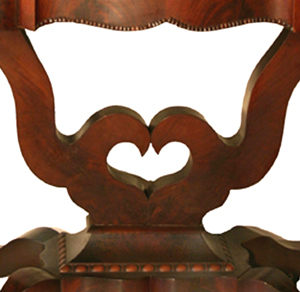
When a cabinetmaker is all done with a piece what happens next? In many cases it goes for peer review, meaning a spouse or co-worker who generally offers a supportive but sometimes suggestive remark like “Isn’t it a little plain?” or “You could maybe dress it up a bit.”
How? The piece is done.
That’s easy enough, just add some molding, or moulding, to some flat spots and it picks right up.
The addition of molding to “finish out” a piece of furniture goes at least back to classical Greek designs and probably even earlier. The molding is used to emphasize the difference in planes of parts of a piece or to provide bands of reflected light to enhance the outline or texture. According to The Encyclopedia of Furniture by Joseph Aronson, moldings generally fall into three categories: flat, single curved and compound curves. The single curved molding include the cavetto, commonly called a quarter round; the ovolo, the reverse of the quarter round; the flute, a shallow groove; the torus, commonly called a half round; the astragal, a small torus or bead; the scotia, a deeper version of the ovolo; and the roll, a three-quarter round.
Compound curves include the cyma recta, a double curve that ends up in the direction it started, the cymatium, the cyma reversa or ogee, a seprentinie or double molding and the beak mold with the upper part concave and the lower part convex.
Among the flat moldings are the band or fascia, flush with or sunken into the surface, the fillet, a raised band, and the chamber, an inclined band. The flat moldings are the most commonly seen and have some of the best names. Here are some frequently seen examples of flat molding.
DENTIL MOLDING – This is a common molding seen on Federal pieces and qualifies as a fillet molding. It is a decorative trim molding of evenly spaced square or rectangular blocks that resemble teeth. Why it is spelled “dentil” instead of “dental” is lost on me. The dentil molding on this Colonial Revival china cabinet is easily identified just below the pediment. 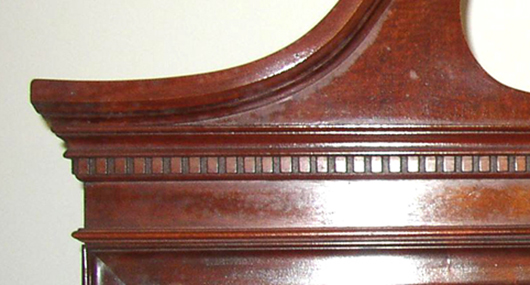 Fred Taylor photo
Fred Taylor photo
Other types of flat moldings that may be either band or fillet are the Greek key and the egg and dart. The Greek key is a symmetrical design that includes interlocking right angle and vertical lines to resemble a set of intertwined squares. “Egg and dart” is a surface decoration derived from classical Greek décor. It was first used in the West by English architect William Kent in 1730. The pattern, seen on molding and inlay of classical pieces, consists of a series of partial circles (the egg) with a pointed design (the dart) between them. The pattern can be seen on flat molding or on single curve molding.
RIPPLE MOLDING – One of the more intricate flat moldings is an inclined band molding known as a ripple molding. This type molding first appeared in Empire style furniture in the 1830s. The ripple molding seen here is on a wall cabinet from the 1840s. While the cabinet was well made and certainly functional, it would have been very plain without the ripple molding on the drawer and around the mirror. It is made by hand on a three section sliding jig that moves hand-operated cutters at regular intervals. This version is a uniform ripple pattern with each group of rises evenly spaced and each channel the same depth. 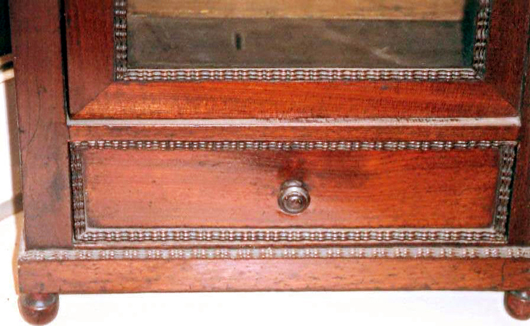 Fred Taylor photo
Fred Taylor photo
MODIFIED RIPPLE – The ripple molding seen in this Empire example is not the uniform pattern seen in the example above. Here there is a difference in spacing and depth with a deeper central channel. It is still hand made using a jig but is a little more difficult to make. It was seen on more expensive pieces of the mid-19th century. 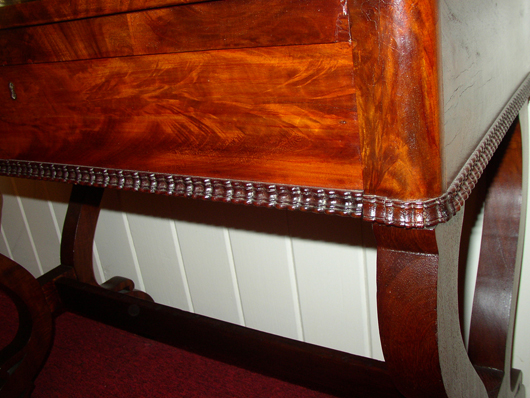 Fred Taylor photo
Fred Taylor photo
SINGLE RIPPLE – The traditional triple ripple molding was used around mid-century and even resurfaced in the late 19th century as part of the Empire Revival period of the 1890s. But the idea didn’t die there. It appears here as a unique single ripple on a marble- top vanity from the early 20th century. 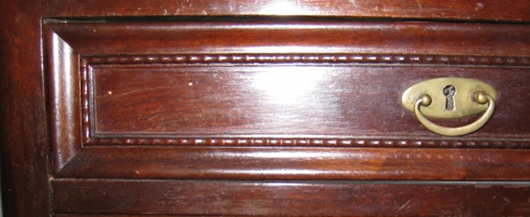 Fred Taylor photo
Fred Taylor photo
MODERN RIPPLE – An even more recent example of the triple ripple molding is seen on the edge of this Colonial Revival Depression era reproduction of a Chippendale desk.  Fred Taylor photo
Fred Taylor photo
REEDED – Another example of flat molding is the triple raised edge seen on this eighteenth century English pedestal table. This type molding with multiple, usually three but sometimes more, individual closely set ridges or raised lines is called reeded molding. The opposite of that configuration, with multiple concave lines is said to be fluted.  Fred Taylor photo
Fred Taylor photo
BEADED – Both types of molding seen on this Late Classicism game table on the skirt and the base are a variation of the single curve molding called the torus. In this case the half round torus is divided into rounded sections of beads and is called astragal molding.  Fred Taylor photo
Fred Taylor photo
GADROONING – Another variation of the astragal molding is seen on the top edge of this secretaire a’ abattant. It is called gadrooning. In this case the beads of the astragal are shaped into opposite facing ovals that line the top edge and form the border for the front of the desk.  Fred Taylor photo
Fred Taylor photo
Send your comments, questions and pictures to Fred Taylor at P.O. Box 215, Crystal River, FL 34423 or email them to him at info@furnituredetective.com.
Visit Fred’s website at www.furnituredetective.com. “His book How To Be a Furniture Detective” is available for $18.95 plus $3 shipping. Send check or money order for $21.95 to Fred Taylor, P.O. Box 215, Crystal River, FL 34423.
Fred and Gail Taylor’s DVD, “Identification of Older & Antique Furniture” ($17 + $3 S&H) is also available at the same address. For more information call 800-387-6377, fax 352-563-2916, or info@furnituredetective.com. All items are also available directly from his website.


